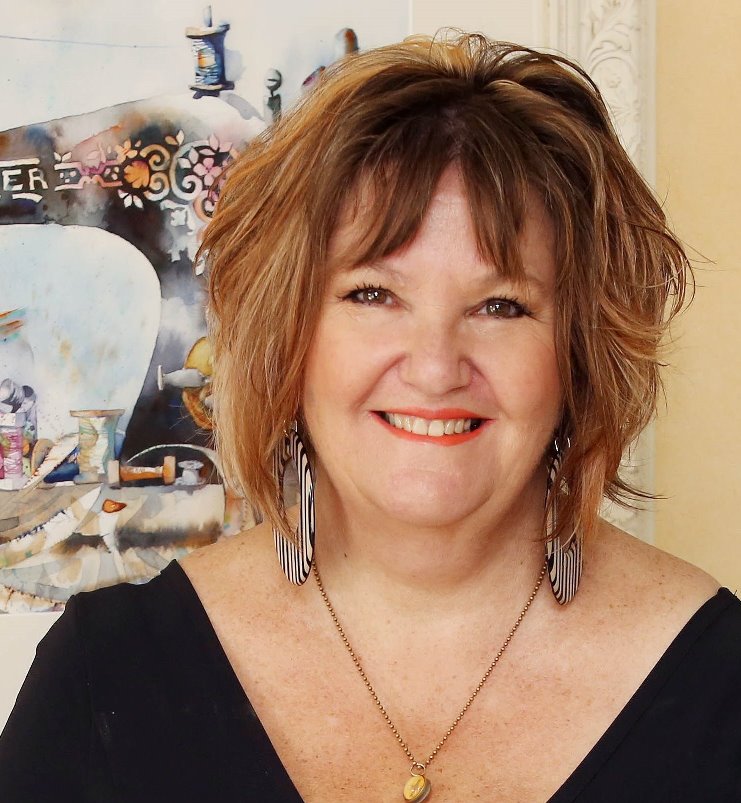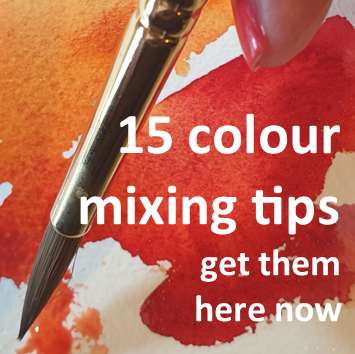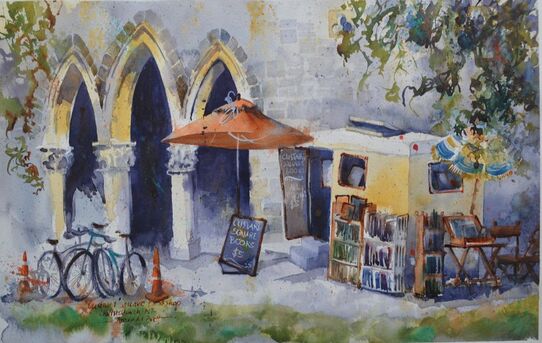 Custard Square Bookshop, Christchurch, New Zealand Custard Square Bookshop, Christchurch, New Zealand
Jude asked:
Do you always plan out everything ie... colours for everything and where bikes, cones etc might go? Yes I do plan everything out BUT as I'm a little haphazard (read Arty-Farty - aka rip sh*t and bust!) I'm also happy to let go and see where the "unplan" takes me. So sometimes my painting is not like my sketch (sometimes my sketches are not like the scene!!). You know that I pretty much always map out my design in a thumbnail sketch first. This sketch is about studying the pattern of the light and the dark and working out a composition. It's not about detail. I'm working out how I can use them to move the viewers eye around the painting. this sketch also helps me to learn about the scene/subject, it helps me to discover areas that could become a problem, or elements that I can take advantage of eg interlocking and overlapping shapes. I make a "shopping list" of elements in the scene that I may or may not want to add into my painting and choose the ones that I like or help me to tell my story. Once I've drawn my map onto my watercolour paper, I sometimes find there are areas that could be utilised or need a little filling up, these ideas come from my shopping list. with regard to palette selection, I'm often smitten with a particular palette for a year or two and then replace a pigment or two. I usually use the same foundation palette for my realism work, based on transparent primary pigments, just the three plus burnt sienna, the same three I recommend to beginners. These colours will mix into every colour you could possibly need - just as well if you're in lockdown and no art supply store!! Divertiti tutti!!
0 Comments
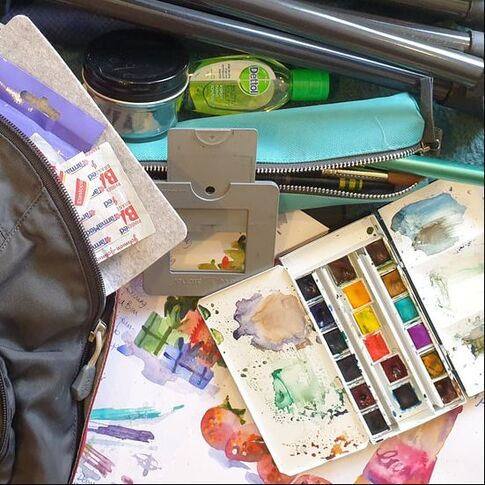
I'm still in my self-imposed "lockdown" with my continuing knee problem, It's a lot better but not better enough .. thwarted by my feeble attempts to "keep calm and carry on".
Something that’s really bugging me is my studio clear-out/tidy up/re-shuffle/reorganise started before Christmas. It was a good idea at the time but now I have 2 piles on the floor that are attempting to morph into 3 and I can’t get down there to do much about it. It’s making me crazy! PLUS while I’m nursing my poor wee ginocchio Dennis has now gone back to work, Amy’s back to work and there’s no-one here to entertain me!! YIKES!! So now I find myself in this temporary situation of cabin fever - I'm desperate to get out and paint/sketch, so I've made myself a new plan for my coming escapades. in a feeble attempt to get back to normal, i went for a walk with Amy and the dog. I trailed far behind them, it was so nice to be out and hearing the birds and children playing, families and their picnics but, I have to say, I paid for it the next day ... mamma mia!! It reminded me how dependent I am on my walking, it's my chief thinking time, my meditation and quiet time that allows my thoughts and ideas to run and play out. Another purpose for me is exploration, this is when I see things that inspire me, a fleeting light, shapes interlocking and overlapping, colours or some other interesting and diverting sights. To get out of the house, I've been for a few outings in the car (bicycle is a no-go atm) to scope out some sketching locations but of course, even here in Auckland it's almost impossible to park close enough. So I've decided to go to cafes again, they have to be in the right place, scenic and comfy. There are so many ways to enjoy sketching out, for me, its a totally absorbing experience. Although I love my little value thumbnail sketches, I learn a lot about a scene using this process, I feel the need to change things up a little, expand my sketching and bring more of it into my life. So!! I bought a new sketchbook and made a sketch kit that's always with me. My new sketchbook has a soft cover, so a little lighter than a hard cover but I found an old light but rigid clipboard. My backpack is pretty old, so old it doesn't have a smart phone size pocket - urk! It has a great "book" pocket but without an easy small pocket, pretty much everything falls to the bottom. In my bag I also have a wee first-aid kit, a small professional pan-set, tramper's collapsible water cup, pencil case and a few other weird sketch tools to fun things up a bit! In my pencil case, I have my standard soft pencils, a sharpener and eraser, tombow value brushpens, general’s sketching pencil, small view finder, calligraphy sketch pen, pastel and watercolour pencil, travel brush, small flat brush, water spritzer. To protect pencil tips and brush points, I always place them in the case in the same direction and then “up” in my bag. In Sketch class last week, Mary said “I can’t see enough detail, I’m too far away”. I agree, I need to see exactly what goes on, this helps me to build my story. Go for a walk to understand the lay of the land, what makes this place tick? How do those elements look close up? Always have your camera charged and set to hi-resolution and use a view finder to isolate your scene and cut out the overwhelming and extraneous, then you can just focus on what you want today. have fun!! ciao Amanda 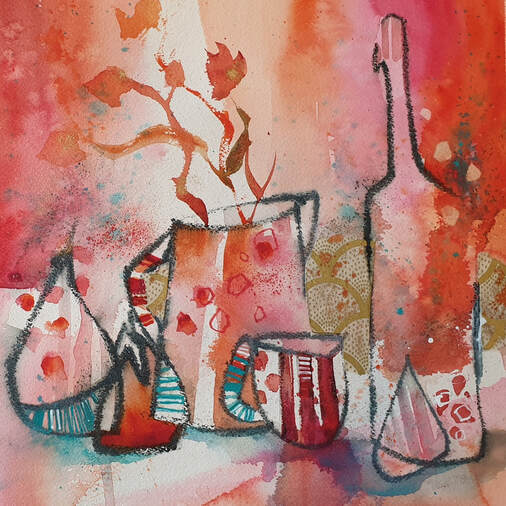
One of the reasons I love watercolour painting is the speed at which I can achieve a painting. If and when I'm clever, I can have a painting today! It took me a long time to get to this point - I've been painting watercolour close to 30 years - it's not an overnight process!!
A huge obstacle for watercolour newbies is allowing the watercolour to have it's way. There's a saying "before I paint, I'm in control, once I put that brush down the watercolour takes over". The secret is, until you get a really good feel for water balance in your brushes, paint and paper, you need to let go and stop trying to control the uncontrollable. Watercolour, as it should be painted, will be difficult for you. Embrace "mistakes" and "accidents", runs and bleeds and allow the painting to speak to you and tell you what it wants. Have another read of my webpage "About Me" and note the last sentence - "I love watching paint dry!" Stop fiddling and controlling and start watching what the paint does and note that where the water goes the paint will follow. You'll start to notice the really cool effects and passages - watercolours will paint themselves if we let them and they'll certainly do it much better than we can! When we're painting watercolour it's time to stop and smell the roses! The scary secret is, you might not get the results you wanted or expected and you certainly might not know what to do next - that's the shock of it!! Use your artist's sense of composition, value structure and design to decide next steps - does it need more darks or lights? are the shapes correct? is it balanced and unified, etc etc. Make a cuppa and watch the paint dry!! ciao i miei belli amici!! Amanda |
AuthorPaintBox Tips, secrets, random thoughts, Poetry in watercolour is made in the freedom of the here and now. Amanda Brett Inspiration exists, but it has to find you working - Pablo Picasso There are no mistakes in watercolour, just some extra surprises!! Categories
All
What my readers and viewers have to say
Your emails are so informative! I must confess I've watched a couple of your demos from beginning to end, and it makes me want to watercolor!!! I've only ever painted with oil or acrylics and haven't know how to begin with WC. Your content is excellent!
Susan VN Hi Amanda
Thank you for your tips. They inspired me to practise and I realised I haven’t been loading the brush properly. I learnt about adding more paint, and not water, to washes. In today’s tips I like the idea of painting with purpose. Your tips are very helpful. I very much appreciate receiving them. Elizabeth Hi Amanda I enjoyed your post and generous tips. Looked up Dan Burt I begin to see that you can colour any subject to give it pizazz so long as the tone and form is correct Certainly adding value now to my attempts Thanks heaps Annie
Yes very wise words. Agree with not fussing and agree with comments about good quality paint. Well written and inspirational as always. Cheers Janet xxxx Archives
July 2023
Copyright © 2022 All images and text on Amanda's blog and website are the the legal property of Amanda Brett and may not be reproduced without express permission from Amanda Brett or her authorised agent. Thank you for respecting her art and the livelihood of all artists.
|

